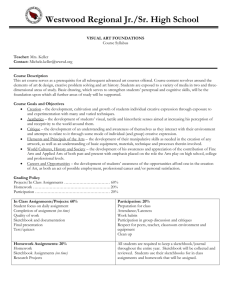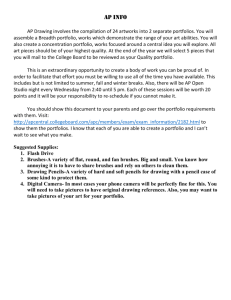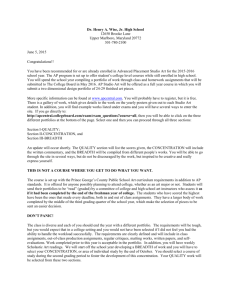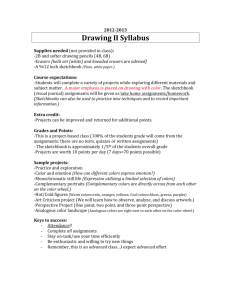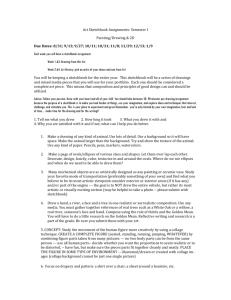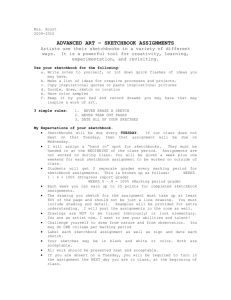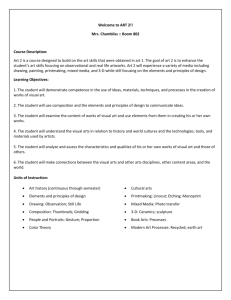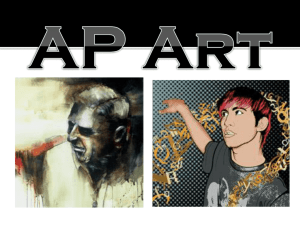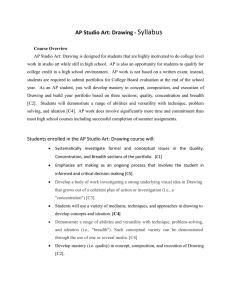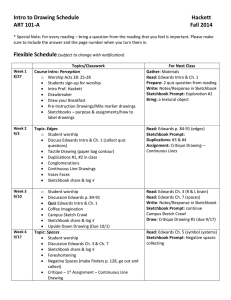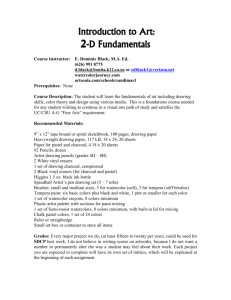syllabus - PersonalDemons.org
advertisement
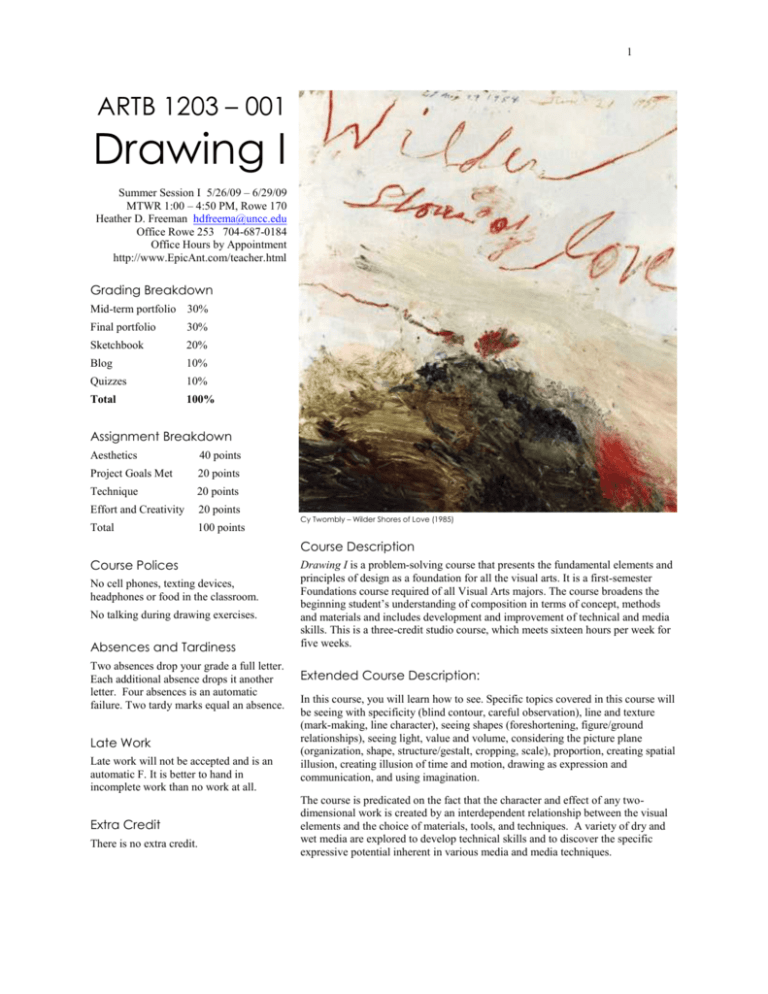
1 ARTB 1203 – 001 Drawing I Summer Session I 5/26/09 – 6/29/09 MTWR 1:00 – 4:50 PM, Rowe 170 Heather D. Freeman hdfreema@uncc.edu Office Rowe 253 704-687-0184 Office Hours by Appointment http://www.EpicAnt.com/teacher.html Grading Breakdown Mid-term portfolio 30% Final portfolio 30% Sketchbook 20% Blog 10% Quizzes 10% Total 100% Assignment Breakdown Aesthetics 40 points Project Goals Met 20 points Technique 20 points Effort and Creativity 20 points Total 100 points Cy Twombly – Wilder Shores of Love (1985) Course Description Course Polices No cell phones, texting devices, headphones or food in the classroom. No talking during drawing exercises. Absences and Tardiness Two absences drop your grade a full letter. Each additional absence drops it another letter. Four absences is an automatic failure. Two tardy marks equal an absence. Late Work Late work will not be accepted and is an automatic F. It is better to hand in incomplete work than no work at all. Extra Credit There is no extra credit. Drawing I is a problem-solving course that presents the fundamental elements and principles of design as a foundation for all the visual arts. It is a first-semester Foundations course required of all Visual Arts majors. The course broadens the beginning student’s understanding of composition in terms of concept, methods and materials and includes development and improvement of technical and media skills. This is a three-credit studio course, which meets sixteen hours per week for five weeks. Extended Course Description: In this course, you will learn how to see. Specific topics covered in this course will be seeing with specificity (blind contour, careful observation), line and texture (mark-making, line character), seeing shapes (foreshortening, figure/ground relationships), seeing light, value and volume, considering the picture plane (organization, shape, structure/gestalt, cropping, scale), proportion, creating spatial illusion, creating illusion of time and motion, drawing as expression and communication, and using imagination. The course is predicated on the fact that the character and effect of any twodimensional work is created by an interdependent relationship between the visual elements and the choice of materials, tools, and techniques. A variety of dry and wet media are explored to develop technical skills and to discover the specific expressive potential inherent in various media and media techniques. 2 Critique Course Objectives Critique is when all complete student work is discussed by the class and the professor. It is your only chance to give and receive feedback on your work, so you need to be present and prepared. Even if you have your own work handed in, if you miss the critique of your peers, your own work will be downgraded a full letter grade for missing this critical class. • Learn to solve visual problems in inventive and creative ways Grading • Compose with a progressively more comprehensive knowledge of the elements and principles of design, building upon early understanding and discoveries • Begin to understand the relationship between form and content • Explore materials and develops technical skills important to upper level courses • Participate in group critiques that (a) further explore and probe the limits and ranges of problem solving, and (b) challenge and advance skills of verbal articulation and critical analysis • Explore the impact of presentation on the way a work is perceived “A” work is superior, meaning a student who does above and beyond what is asked. Course Requirements “B” is very fine, completing work that is above average but not pushing it fully to A quality work. Submit a mid-term and final portfolio of work “C” is satisfactory, average work. The student has completed everything that was asked, but has done nothing more than that. “D” is less than satisfactory; the student has not followed directions or fully completed the project. “F” is inadequate, unacceptable work. Missing Projects No student will pass this course if any assignment is missing. Leonardo Di Vinci, “Study of Embryos” ~1520 Complete all in and out of class assignments Keep a sketchbook which will be collected and graded Complete a minimum of six thumbnail sketches per assignment in sketchbook, along with other assignments given Complete a blog containing images of major assignments and in-class exercises and specified homeworks. Complete written quizzes Thoughtful class participation Reworking a Project All projects may be resubmitted for a new grade the following Monday only. The first and second grade will be averaged together. Work not handed in at the beginning of class on Monday for grade reconsideration will not be accepted. 3 MATERIALS Attendance Recommended Text (not required!) Betti, Claudi & Teel Sale, Drawing: A Contemporary Approach, 5th Edition Certain absences are excusable (family crisis, death in the family, etc.) but you must provide me some verifiable evidence of the event. Even an excused absence, however, may effect your final evaluation if it results in missed deadlines and understanding of course concepts. It is your responsibility to check with a classmate about notes taken during a missed class. See me immediately for assignments missed. You will be expected to complete missed work as soon as possible. If you miss three or more classes for personal reasons, you are strongly encouraged to withdraw from the class. Supplies Resources: UNCC Bookstore Cheap Joe’s, 4420 Monroe Road, Charlotte, 704-333-2527 Binders, Cottswald Shopping Center, 284 S. Sharon Amity Rd., Charlotte, 704-3344611 *Bring to the Second Day of Class: *Sketchbook (11" x 14") *Newsprint Pad 18" x24" 50 sheets *Drawing Pad 18" x 24" (white paper) 50 sheets * Bristol Pad, 14" x 17", 15 sheet pad *Graphite Pencil HB, (H = hard), 2B, 4B, 6B (B = soft) *Graphite stick, 2B * Pencil sharpener *2 Packets of Vine Charcoal, vine, soft, not hard *Compressed black chalk, soft, 2 pieces *Conte Crayons/pencils, 1 black, 1 white, 1 sienna brown, dark brow (split 2 pack) * chamois cloth *Higgins Black India Ink , waterproof *Japanese Brush, medium *Variety of water media brushes, medium round sable # 5, 8 and/or 10 *Drafting tape Two metal clips to hold paper to board Rubber Cement *Kneaded Eraser *Mars white plastic eraser Pencil sized white eraser with holder * Sharpie fine point marker, medium point too Drawing board Plastic Palette with Cover Ruler X-Acto Knife and blades Tackle box for supplies Workable fix * Mi-Tieintes for final projects, 2 white, 2 cream, 2 black, 2 tan, 2 gray, Other paper as needed Portfolio used to submit work at mid-term and end of semester. May upgrade to better quality portfolio for additional cost. Work Time Most assignment deadlines will include in-class work time. This time is specifically set aside to work on the assignment for this class. Come prepared to work. You will be required to dedicate a variable amount of time outside of class (mostly on weekends) to homework and major project assignments. Sketchbook This is a place for your preliminary sketches, notes, etc. You should have AT LEAST six thumbnails for each assignment (three thumbnails per page). The sketchbook will be collected midterm and at the end of the term. Your sketchbook work is very important and accounts for 10% of your final grade! Field Trip We will go to see local art, either at the McColl Center, The Light Factory or The Mint Museum once during the semester. Exhibitions on campus will be seen as they occur. It is important for you to begin to see as much art as you can, if you are sincere in your interest in art. Academic Integrity Without maintenance of high standards of honesty, members of the instructional faculty are defrauded, students are unfairly treated, and society itself is poorly served. Maintaining the academic standards of honesty and integrity is the responsibility of the entire academic community. All work in this class must be original. Violation of this is considered plagiarism and the university code of student academic integrity will be enforced (please visit http://www.legal.uncc.edu/policies/ps-105.html for the entire code). Students have the responsibility to be familiar with and observe the requirements of The UNCC Code of Student Academic Integrity. This code forbids cheating, fabrication or falsification of information, multiple submission of academic or artistic work, abuse of facilities and equipment, and complicity in academic dishonesty. The normal penalty is zero credit on the work involving dishonesty and further substantial reduction of the course grade. Diversity Code UNC Charlotte strives to create an academic climate in which the dignity of all individuals is respected and maintained. Therefore, we celebrate diversity that includes, but is not limited to ability/disability, age, culture, ethnicity, gender, language, race, religion, sexual orientation, and socio-economic status. 4
